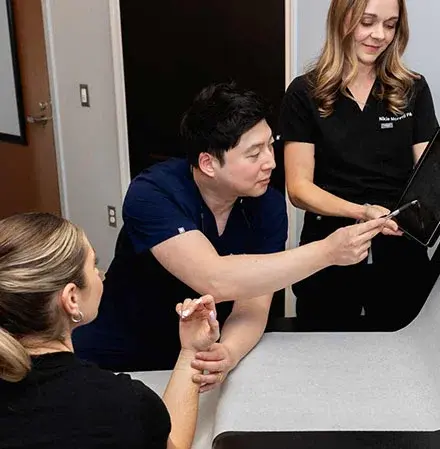We offer our patients a world-class phrenic nerve injury program and phrenic surgery aimed at reversing diaphragm paralysis, pioneered and led by The Institute for Advanced Reconstruction’s very own world-renowned Dr. Matthew Kaufman, MD, FACS located in New Jersey.
Reverse Diaphragm Paralysis with our Phrenic Nerve Program
Request An Appointment at The Institute for Advanced Reconstruction
We are the only known center in the world to offer innovative surgical treatment for phrenic nerve damage.
Our results speak for themselves.
Phrenic Nerve Surgery and
Phrenic Nerve Program


The phrenic nerve controls function of the diaphragm muscle, the primary muscle involved in breathing. When this nerve becomes damaged, phrenic nerve reconstruction may be performed to reverse diaphragm paralysis.
Until now, treatment options for phrenic nerve injury have been limited to either nonsurgical therapy or diaphragm plication, neither of which attempts to restore normal function to the paralyzed diaphragm.
Thanks to recent advances in nerve decompression and transplant leading to Dr. Kaufman’s surgical breakthroughs, it is now possible to reverse diaphragm paralysis using techniques derived from the procedures commonly used to treat arm or leg paralysis, enabling surgeons to restore function to previously paralyzed muscle groups.
How
We Can
Help

Phrenic Nerve Reconstruction
29 Conveniently Located Offices Across New York, New Jersey, and Pennsylvania

Building 2 - First Floor, STE 200
Red Bank, New Jersey 07701



Suite 4
Glen Ridge, New Jersey 07028


.jpg?width=439&quality=high)









Suite 121
San Francisco, California 94114

Rear Entrance
New Orleans , Louisiana 70130


7th Floor
Neptune City, New Jersey 07753



Building 200, Suite 200
Cape May Court House, New Jersey 08210





Consultation for Phrenic Nerve Reconstruction: Is it right for you?
In order to best assist you, and expedite your inquiry about our procedure, a paralyzed diaphragm should already be diagnosed.
You will be asked to provide the following information:
- When were you diagnosed with a paralyzed diaphragm (month/year)?
- What side(s) of your diaphragm is paralyzed?
- Did you have surgery or trauma that caused damage to your phrenic nerve?
- Do you experience numbness and/or tingling in your upper extremities?
- When was your most recent SNIFF (Chest Fluoroscopy) test completed?
- When was your most recent Pulmonary Function Test completed?
- Have you had an EMG nerve study completed of your phrenic nerve and diaphragm?
About Dr. Matthew Kaufman, MD, FACS
Dr. Matthew Kaufman, MD, FACS, is an award-winning cosmetic and reconstructive plastic surgeon, board-certified in both Plastic Surgery and Otolaryngology-Head and Neck Surgery, and is a Fellow of the American College of Surgeons (FACS). He performs phrenic nerve surgery at The Institute for Advanced Reconstruction, based in Red Bank, New Jersey, and the David Geffen School of Medicine at the University of California at Los Angeles (UCLA).
Dr. Kaufman pioneered the phrenic nerve program at The Institute for Advanced Reconstruction and is actively involved in the training and education of the program’s specialists. He has published a number of academic articles in medical journals and appeared at both national and international medical conferences speaking about the procedure.
About
The Institute for
Advanced Reconstruction
The Institute for Advanced Reconstruction is uniquely positioned as the ‘go-to’ center for revolutionary nerve procedures, as well as world-class reconstructive treatments.
These include cutting-edge procedures such as nerve transplantation that may restore a significant degree of function for those who have suffered from stroke and other forms of paralysis. Patients who at one time believed they had exhausted their paralysis treatment options come from around the country and the globe to our practice in New York City and Red Bank, New Jersey.
The Institute for Advanced Reconstruction is also composed of the Axon Advance Foundation, a non-profit organization focused on new horizons in research, innovation and surgical treatments for peripheral nerve damage and spinal cord injury.
Frequently
Asked
Questions
Approximately 40 percent and growing. Each case requires a lot of time. In addition to the actual procedure, there is extensive pre-surgery preparation since most of the patients are from out of town. There’s a tremendous amount of time that goes into preparing each one. To fly across the country, or from someplace else in the world, and have a unique surgery requires careful planning to maximize a successful outcome.
It’s probably more common than most people think, but hard to know. For example, what percentage of those with this problem are finding us at The Institute for Advanced Reconstruction?
I think there are some standard causes. If you break it down into broad categories you have a surgical injury (i.e. damage to the nerve while being operated on for other causes), an anesthetic injury (e.g. inadvertent phrenic nerve damage by a needle passed into the neck), a manipulation injury (e.g. chiropractic), or some type of trauma (such as a fall from a horse, a car accident, or even a freak event such as twisting the wrong way).
Age is a big factor for recovery; young patients regenerate better than older ones. Among our patients, the 25-50-year-olds do much better than the 60-70+-year-olds in terms of recovery.
Two-thirds to three-four of the patients are men. Men have more injuries in general—so they undergo more surgery, as well as chiropractic, and are more likely to get injured from it. Secondly, men are usually bigger and heavier—so if the neck and (big, heavy) arm twist, there is potentially more damage.
Idiopathic Diaphragm Paralysis is the diagnosis applied when the cause of the diaphragm (breathing) paralysis is not known. For example, if there is no obvious acute trauma to the neck or chest, and there has not been any procedure or intervention that may have inadvertently caused a phrenic nerve injury.
Idiopathic Diaphragm Paralysis has traditionally been thought to occur from a “mystery” virus (often termed Parsonage-Turner syndrome or viral neuritis), however from our vast experience in evaluating thousands and treating hundreds of patients over the last fifteen years, we have clearly identified that most cases of Idiopathic Diaphragm Paralysis are actually a result of chronic peripheral nerve compression in the neck region.
Chronic nerve compression of the peripheral cervical roots and phrenic nerve is a kind of “wear and tear” phenomenon, likely related to a cumulative impact of past “mini-traumas.” Examples could include contact sports, work-related damage (e.g. manual laborers, tech-neck) or exercise injuries. Unfortunately, there is no way to accurately identify compression of these small nerve structures on an MRI. However, we do rely on cervical MRI to eliminate the possibility of spinal cord compression. We also perform complete diagnostic testing to rule out the possibility of a viral cause or a generalized neurological disorder (e.g. Amyotrophic Lateral Sclerosis, Charcot-Marie-Tooth disease).
In many cases, yes. At The Institute for Advanced Reconstruction, we have pioneered phrenic nerve reconstruction for the treatment of diaphragm paralysis. We have the world’s greatest experience in this procedure to restore functional movement to the diaphragm, including successfully treating many patients with presumed “Idiopathic Diaphragm Paralysis.”
Each patient is required to go through the necessary diagnostic testing to determine if they would be a surgical candidate.




















